Welcome to the week.
Here are the most notable items that our editors and readers came across in the past seven days…
Oregon’s transportation opportunity: The Street Trust Executive Director Sarah Iannarone deftly lays out ODOT’s current freeway-building follies and shares a plan for how to spend the influx of federal funds that will take us “from gridlock to greatness”.
Where things stand in Oregon: A must-read, front page story in The Oregonian makes it clear that Oregon’s transportation status quo of freeway expansions and investments in more driving capacity isn’t nearly enough to reach our climate change goals.
You get an e-bike! And you get e-bike!: Feels like each week the clamor for more e-bike adoption grows louder, now a NY Times opinion writer is pushing the idea that if we really want to fight climate change, everyone should be given a free e-bike. And making this piece even stronger is that it was picked up by MSNBC and featured in a segment on All In with Chris Hayes!
Cycling through grief: A wonderful essay from a woman who rediscovered biking in mid-life and then realized that pedaling helped her deal with the loss of her mother.
Gamify low-car life: We love some good transportation demand management, so I was so happy to see the success of this “Beat the Street” campaign in London that got people to stop driving so much.
Advertisement
A “deadly myth”: David Zipper is back in The Atlantic with a vital myth-busting article that implores DOTs and other safety orgs to drop the false “94% of all crashes are caused by human error” mantra.
Major movie news: Hollywood is poised to finally recognize the amazing life of bicycle racing pioneer Major Taylor, a Black man who dominated the track in the Jim Crow era. Adding to this exciting news is that 10-time national champion Rahsaan Bahati will be a consultant on the film.
EV-cars are boring: With news that Apple is producing an electric car, this commentator says a much more exciting — and revolutionary — prospect would be an ebike… I mean, an iBike.
Birth-by-bike: A member of New Zealand’s parliament went into labor and rode her bike to the hospital just hours before giving birth.
Start planning now: This is a good time of year to plan your summer bike adventures. With that in mind, here’s an inspiring update on new additions to the US Bicycle Route System.
Thanks to everyone who sent in links this week. We appreciate you!

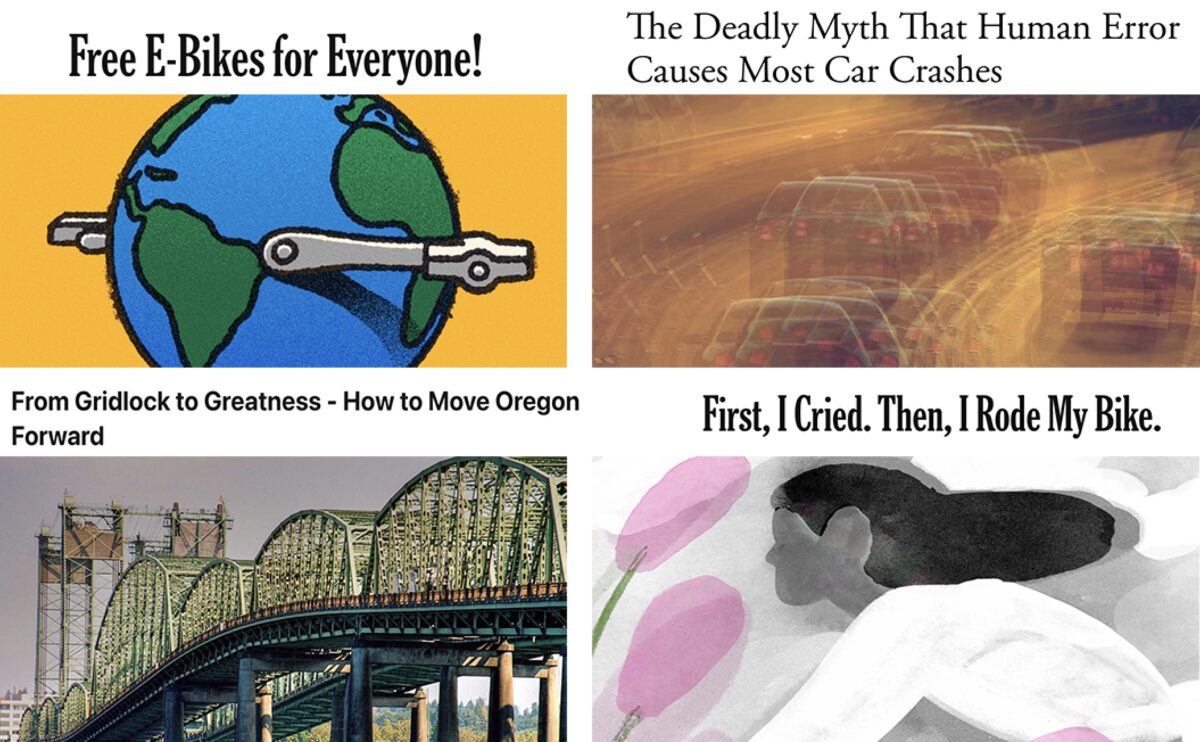
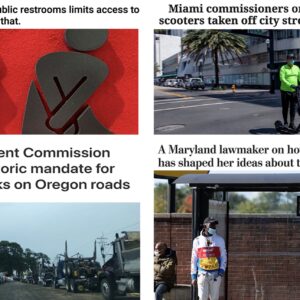
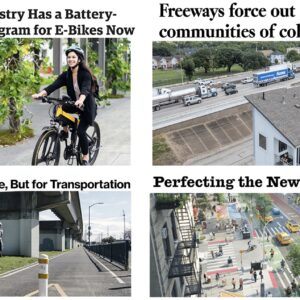
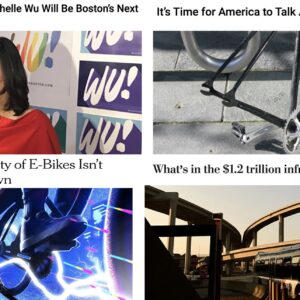
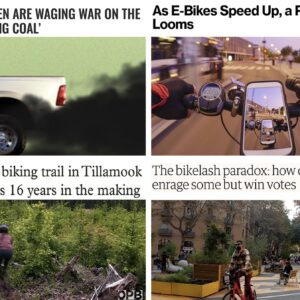
Thanks for reading.
BikePortland has served this community with independent community journalism since 2005. We rely on subscriptions from readers like you to survive. Your financial support is vital in keeping this valuable resource alive and well.
Please subscribe today to strengthen and expand our work.
The Iannarone editorial says all the expected things without really getting into any of the tricky issues. For example, it argues for expanding transit without addressing the vast inefficiencies (both operationally and environmentally) that would accompany it if ridership fails to reach certain levels (which it likely wouldn’t — most routes with sufficient demand are already being served), or the dramatic fall in ridership that transit systems have experienced post-covid.
She poo-poos electric cars, which, while having some significant drawbacks, are really the only possible way to rapidly draw down CO2 emissions (which I agree should be a primary metric by which any new transportation system investment proposals are judged).
Doubling down on biking is unlikely to happen, given PBOT’s current “what bike plan?” leadership, and unlikely to be effective given that ridership has stalled or fallen in the face of lots of new investments in facilities. (And the complaint that cars don’t work for everyone is trebly true for bikes.)
So what we’ve got are the same old bromides that just don’t feel relevant in today’s world where driving has surged and become largely deregulated. We need new ideas and new thinking if we’re going to change the status quo, which has become even more entrenched compared to the 20th (and 19th) century alternatives currently on offer.
The anti-electrification propaganda from many influential active transportation advocates is incredibly disappointing. It’s also informative that the underlying citations used to parenthetically dismiss electrification almost always stress how important EVs are to transportation sector decarbonization.
A direct quote from the source document of Ms. Iannorone’s citation:
The quixotic unwillingness to acknowledge that EVs are essential and a propagandistic focus on their limitations makes many advocates unwitting proponents of the fossil-fuel status quo (mainstream car culture is also deeply suspicious of EVs). The USA is certainly capable of a rapid transition to EVs, as evidenced by the increasingly rapid transitions in other wealthy nations, and this ongoing process of electrification is an opportunity to make personal mobility modes a part of that essentiality.
FWIW I’m not anti-EV car… I just see that EV bikes are being left out of the conversation far too often. I am also very concerned that the EV-car lobby is very car centric and is funding by a lot of car companies. I also feel that EV cars don’t solve nearly as many problems as easily and as quickly as folks would have us believe. They are very good for greenwashing highway projects tho
FWIW, I also thought it was striking that the editorial did not mention other forms of e-mobility. Given the society we live in, the “EV” is coming whether we want it or not. I would hope that active transportation advocates can see that there is an emerging opportunity to expand what is considered an “EV”.
Agreed — it feels a bit like anti-nuclear propaganda leading to existing plants being closed prematurely. I’m not exactly pro-nuclear, but I can do the math*, and taking active steps to make decarbonization harder in the short term just seems foolish. Opposing vehicle electrification seems a similar triumph of dogma over reality.
*A subject which is itself experiencing a bit of dogmatic attack, but that’s a different topic.
The issues that Tepco and the Japanese government had with controlling the crisis at Fukushima didn’t inspire confidence in drastic expansion of nuclear power to the point where it replaces fossil fuels. And molten salt reactors would take decades to come online in any numbers. Then there is the issues with dealing with the spent fuel waste that is deadly for thousands of years.
I agree, it may be our only hope. But there are major unresolved issues that give many pause.
I don’t think long term nuclear waste storage technology is as simple or safe as you make it sound.
As I said, nuclear may be the only way to produce enough “clean” energy to allow us to survive at our current rate of power consumption and resource usage. But it takes decades to get new reactors up and running. And many existing pressure vessels are at the very end of their useful lifespan. We done goofed and cooked ourselves with co2 and methane. Might have to take the L on this one.
What? LOL. There are tens of thousands of underserved people on the peninsula that aren’t connected in any meaningful to the rest of the city.
Greatly looking forward to the Major Taylor pic. Never understood why African Americans are under-represented in cycling.
Even if every single freeway project were cancelled Oregon’s contribution to global CO2e emissions would continue its sharp rate of increase*. After all, Oregon’s consumption-based emissions are larger than SUV/truck/(sedan) tailpipe emissions. Given that transportation emissions are already increasing with a status quo amount of freeways, this type of USAnian middle class activism# does not even aim to decrease this region’s aggregate sector-based emissions (which is tragic and immoral at this point in time).
Moving deck chairs around the Portland or Oregon balcony of our planetary ship does little to stop our ship from sinking. The climate crisis is not a local$ environmental crisis, it’s a systemic political crisis that has been unaddressed for many decades.

https://www.oregon.gov/deq/aq/programs/Pages/GHG-Oregon-Emissions.aspx
* The vast majority of Oregon’s consumption-based emissions come from the Portland metro area but Portland stopped measuring these emissions for reasons that BDS and city commissioners refuse to explain.
# As Daniel Aldana Cohen and others have shown there is a high correlation between dense urbanization and consumption-based emissions (Fordist/Post-fordist urbanism is an ecocidal movement, according to my opinion).
$ Localism is a form of nationalism.
The Consumption-based metric includes emissions from Oregonians’ vehicles. In fact, it is the largest single contributor to it. The sector and consumption values are not mutually exclusive metrics, just different ways to look at/measure emissions.
From the report:
“The purchase and use of vehicles and parts is the largest category in the consumption-based inventory.”
A reduction the the number of cars and miles driven in Oregon will reduce “consumption-based emissions,” at least as measured by the report you linked.
Ironically, you are making my point. Instead of wasting enormous advocacy resources to preserve our freeway status quo we should focus on rapidly eliminating consumption-based emissions (including all forms of freight/transportation-associated consumption).
For a consumption-based society that does not produce much (e.g. the USA, Oregon, and Portland), consumption-based emissions are the appropriate measure.
First of all, the purchase of vehicles only represents a tiny fraction of Oregon’s consumption-based emissions (~3%).

Secondly, embedded emissions due to purchase of goods and services and air travel (business and government) make up the majority of this category as can be seen by its small contribution to household emissions.

I very much agree but there is no evidence that preventing a particular freeway expansion will reduce current consumption of goods (and associated vehicle-based emissions), VMT, or vehicle purchases .
Considering you’re discussing what people and groups of people should do, I can’t agree with the idea that just one way to measure emissions is appropriate. That sounds like suggesting people should advocate for one particular reduction while ignoring another particular reduction, which I’d say is not helpful even if one reduction happens within the other. I’d prefer some advocate reducing freeway expansion while others simultaneously advocate reducing consumption-based emissions, especially since different people and organizations have different control over each, and nobody can do more than one thing in a moment.
As to your last note, I agree, but I don’t believe that’s any reason we shouldn’t discourage every particular freeway expansion to prevent future consumption, especially given this conversation being in the context of the Oregonian article which raises various ways to discourage usage of our current freeways and encourage alternatives.
Ending question related to your higher up post, since I haven’t read the reports you have: given that the Portland metro is home to more than half of Oregon’s population, how far off proportional is the area’s consumption-based emissions from that of the state’s total, and does what you’ve read account for consumption that happens in the metro area by people who travel there (whether from the rest of Oregon, another state, another country, whatever)?
Mitigating ecocide is in aggregate a CO2e math problem. With all due respect, arguing that we should prioritize small components of our contribution to global CO2e emissions due to our hyperindividualist capitalist preferences is just a more socially-acceptable form of climate science denial.
Not only is there no organized group advocating for this but many “environmentalists” bristle at the idea that middle class/upper class USAnians* should sacrifice their current way of life for the greater good.
Portland’s consumption-based emissions are almost certainly disproportionately larger than those of more rural areas of Oregon (based on C40 estimates for other cities) but this city refuses to even inventory them.
I never stated that we should not discourage freeway expansions. I believe we should discourage automobility, in general.
*virtually all of which are members of the global 1%
Humanity’s hyper-individualist leanings very much frustrate me, too, but somehow I seem to be misunderstanding you in other regards. How do you think we can prioritize consumption-based emissions without prioritizing various small components which factor into that amount? Without transportation and vehicle use, much consumption in other sectors would not be possible, for instance.
I lean toward agreeing with you here, though I know no figures supporting what you say.
Almost certainly doesn’t sound convincing, nor does it answer my questions about taking into account consumption from people who don’t live in Portland, but travel there to consume. I’m with you in disdain for that lack of inventory, though.
I’m glad to read that, because I was unable to glean as much from your previous posts in this thread. Thanks for all your answers.
Portland’s only inventory of consumption-based emissions was conducted prior to the 2015 climate action plan release (data up to 2013). Prior to its CAP release, Portland made a committment, as a member of the C40 coalition, to track and reduce its consumption emissions. Unfortunately Portland has failed to conduct additional inventories in two subsequent updates and has stonewalled/ignored requests by activists (including me) to explain this failure*. The 2013 dated CAP inventory showed that Portland’s consumption-based emissions dwarfed sector/production-based emissions# and that most of these emissions came from consumption by Portland metro residents.

https://www.c40knowledgehub.org/s/article/Data-story-what-Portland-learnt-from-their-consumption-based-emissions-inventory?language=en_US
*The State of OR has continued to conduct consumption-based inventories (see above) so Portland’s refusal to address this issue indicates intentionality.
#There are methodological limitations to Portland’s pre 2015 consumption inventory and its likely that a scientifically rigorous analysis would find higher emissions.
I believe our only path forward is a systemic approach based on the climate science consensus (e.g. the mitigation pathways in the SR1.5 and forthcoming AR6). Limiting our focus to “fossil fuel production” or transportation (e.g. a “transition”) is nowhere near enough to prevent ever more grotesque ecocide:
https://www.nationalgeographic.com/environment/article/climate-change-model-warns-of-difficult-future
I had to do some googling to keep up with you two here, but good thread. Thanks both for giving a damn.
Correction: BPS not BDS.
The Atlantic article is frustrating because it makes the assumption that if we categorize things like not seeing a speed limit sign as “driver error” then the engineers and regulators will simply ignore design problems because “it’s the driver’s fault”.
The scenario the article is built around is clearly one of driver error — even if one doesn’t see the speed limit sign, and even if the road does not physically narrow, it is pretty clear to most drivers that they need to go slower when entering a built-up area in foggy conditions, especially if the driver is not familiar with the area (if they were, they’d slow down out of habit). Most navigation systems warn of speed limits which can act as a redundant system to seeing a sign.
It seems unlikely that an engineer will look at a pattern of crashes and decide they have no role in solving the problem because it’s simply a repeated “driver mistake”; there are thousands of examples of engineering solutions to problems that could be dismissed for that reason.
Likewise, regulators require plenty of auto safety devices specifically designed to address driver error (air bags, for example, were originally required in the event drivers failed to properly buckle their seat belts). Should we require more? Absolutely, but the obstacle is not blaming drivers for crashes; it’s primarily cost, complexity, and manufacturer pushback in a sympathetic political environment.
So yes, of course we can and should engineer roads better and make cars safer. But the fundamental argument of this article, that our failure to do that is due to blaming crashes on drivers, is unsupported and unconvincing.
A really good analysis of this topic comes from a former transportation engineer, Charles Marohn : confessions of a recovering engineer. The bottom line is that very few crashes are really the result of driver error. Our streets are purposely engineered for cars to go faster than the stated speed limits, as that is considered “safe design.” The problem is that the way roads are built, signals to drivers how fast they feel comfortable driving. We all drive as fast as we feel safe driving and on most streets that is well above the speed limit.
https://www.amazon.com/Confessions-Recovering-Civil-Engineer-Transportation/dp/1119699290/ref=asc_df_1119699290_nodl/?tag=hyprod-20&linkCode=df0&hvadid=475772574912&hvpos=&hvnetw=g&hvrand=13407647687693767355&hvpone=&hvptwo=&hvqmt=&hvdev=c&hvdvcmdl=&hvlocint=&hvlocphy=9032826&hvtargid=pla-1187958944116&psc=1
I disagree; while I acknowledge humans have limits to their cognition, if drivers follow the rules, they will largely be spared a crash. They have agency and a responsibility to behave properly.
But the more important point is that it need not be either/or; we can blame those who break the rules AND engineer streets to make it less tempting to violate them AND make vehicles safer for when all else fails. Something as critical as life safety requires multiple layers of protection.
I totally support building better facilities (and suspect I would support many of Marohn’s prescriptions). I very much want us to make investments in safety, even if they are only needed when drivers go wild.
But I do not accept “the street made me do it!” No, you did it.
You hit the nail on the head here. I had the same issue with the above article. We should be addressing road safety on all fronts: enforcement, driver training, and infrastructure. No other county in the “developed” world makes it as easy as we do to get and keep a driver’s license. Ignoring that fact will leave a lot of very dangerous people on the road.
“We all drive as fast as we feel safe driving”?
I don’t. I don’t think most drivers do, either.
I agree that “Our streets are purposely engineered for cars to go faster than the stated speed limits” (often substantially so) and I agree that “the way roads are built, signals to drivers how fast they feel comfortable driving”.
But if people drove as fast as they felt safe driving, they’d be driving as fast as the speeds the roads were designed for. (I think few drivers feel UNsafe driving at the speeds roads were designed for.) Yet many people (of course not nearly enough) drive at or not much faster than the speed limit–at least certainly not as fast as they feel safe driving.
“Very few crashes are really the result of driver error”? I don’t regularly see crashes, but I regularly see near crashes, and I’d say almost 100% are due to driver error.
This isn’t to say that design can’t help reduce the number of errors drivers make, or reduce the likelihood of the errors causing serious damage and injuries.
I think the point is that our roads do not set us up for success. They rely heavily on all drivers “doing the right thing” in complex situations. If we rely on everyone to drive 25 on streets that easily accommodate 35, or to fully stop at every stop sign then we are fooling ourselves. Yes, many, maybe even most follow rules, but that’s not the point ; Enough people drive too fast, or are confused by poorly designed intersections or drive not expecting bikers or pedestrians in the street because there are no sidewalks or poor bike facilities. If streets with a 25 mph speed limit were narrower we wouldn’t need as much enforcement because most people would feel uncomfortable going faster. And sure, there will always be people who just ignore rules and drive too fast, run red lights, text and drive, drink and drive, which is why there will never be 0 crashes. But if you change the geometry of the streets, people will slow down because they won’t feel safe driving faster.
I did not see that assumption in the article, but accept I could have missed it. Can you share a quote or quotes that support your statement?
By my interpretation, the author was instead suggesting our society packs many assumptions behind the notion that human error causes most crashes, and that many of those assumptions contribute not only to our lack of urgency around tackling those costs, complexity, and manufacturer pushback you mentioned, but also the sympathetic political environment you mentioned.
I’d suggest considering the foggy scenario once more, then. If an engineer looks at the situation and concludes, like you have, that most people would have had the judgment to slow down entering that built up area, they might think the design was currently sufficient given project constraints and how most people drive that area, even while acknowledging more optimal designs could have prevented that crash. Auto manufacturers might consider the involved automobile in a similar way. A politician might interpret each designer’s considerations in the same way. A general public might also follow suit. And the road and signage in question might not change for many years to come, with a similar crash happening at whatever rate everyone complacently accepts.
So instead of saying blaming drivers causes our failure to better engineer, I think the article suggests our failure and/or choice to better engineer and/or build is contingent upon many things, many of which are contingent upon our focus on what blame human error plays in crashes.
One example:
This is pocky.
You write:
The most important word here is “constraints”. Resources are limited, and even if the engineer realizes a better design would have been safer, they may not be able to spend tens of millions to reconstruct the street to reduce the likelihood of an already rare occurrence. Yes, crashes in general are disturbingly common, but crashes in any particular place are generally pretty rare, and in a constrained universe, we can’t address every risk.
Most engineers would prioritize safety improvements based on the impact they would have, which is why we use data and judgement to identify and address high crash corridors and intersections, even if it is clearly driver error that causes the vast majority of incidents there.
I see no practical difference to assigning blame to a driver who blows through a red light vs blaming engineering for not converting every intersection to a roundabout. In either case, we do the same thing… look for patterns and try to spend our money judiciously where it will have the maximum impact.
I’m surprised no one brought up Pokemon Go in the gamify article. That’s the largest example of ‘gamifying’ our streets I think anyone could think of. and albeit a temporary trend, it was successful in that there were 1000s of more people walking/rolling/biking in the streets because of it.
The back end of gamifying is that it might not replace existing trips, but simply add more to the streets. But I’m thinking that’s the engineer in me thinking roadways are a capacity issue, not a user experience issue…
Couldn’t agree more about Pokemon Go! Even did a story about it in 2016 – https://bikeportland.org/2016/07/14/pokemon-go-is-a-boon-for-biking-187630
On the US Bicycle Route System, I wasn’t that familiar with it, but it’s interesting that Oregon has zero such routes:
https://www.adventurecycling.org/routes-and-maps/us-bicycle-route-system/maps-and-route-resources/
That’s because Oregon already had a program like that… The Oregon Scenic Bikeways https://traveloregon.com/things-to-do/outdoor-recreation/bicycling/road-biking/ride-oregon-scenic-bikeways/
Still though, I think ODOT should do more with Adventure Cycling on that program to make sure we are in the official national network.
NC has some of those roads in the system – they are among the most terrifying roads to bike. There’s a couple annual sponsored rides that REQUIRE a police escort for safety reasons. It’s up to each state to designate what roadways or trails are included or not – and the roadways selected go a long way towards describing how bad or good a state is at bicycle improvements. NCDOT is notoriously awful.
In NC, WV, & VA, the state DOT owns and maintains all the county roads statewide plus most arterial stroads in cities, part of a 1930s Depression cost savings scheme. NC is #9 in population but #2 in the number of miles of state-maintained roads (Texas is #1).
WV also has nearly no miles in the system (except a tiny portion of the very excellent C&O trail from DC to Pittsburgh), but the state does have an incredible network of rail trails as does Virginia, Ohio, & Michigan.